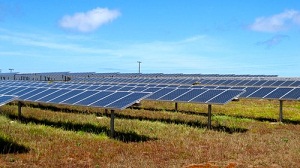Solar energy news: A look back to last week
 President’s Day was last week, making it a short work week for most, but that really didn’t seem to slow down the world of solar. Many companies announced new deals, some for projects and some with mergers starting to occur. It shows that even without some of the governmental support solar had in recent years, its still not ready to slow down.
President’s Day was last week, making it a short work week for most, but that really didn’t seem to slow down the world of solar. Many companies announced new deals, some for projects and some with mergers starting to occur. It shows that even without some of the governmental support solar had in recent years, its still not ready to slow down.
Mid-American Energy Holdings issued what may be the first bonds to support a utility-scale project when it issued $850 million in bonds to support its Topaz Solar Farm. Bonds for the 550 megawatt project were well-received. Requests for the BBB+-rated bonds were exceeded the amount of bonds offered. It could be a sign that more projects could issue such bonds in the future.
In Vermont the potential merger of two power companies, Central Vermont Public Service and Green Mountain Power could mean more solar. If the merger is successful, Central Vermont customers could see a $21 million investment in solar, renewable energy and energy efficiency investments. The state’s Public Utilities Commission will likely rule on the merger by early summer.
Also planning to merge are U.S.-based Westinghouse Solar and Australia-Based CBD Energy. Under the agreement, which is still subject to regulations, both companies will gain increased access to international markets. Westinghouse Solar will use the merger to expand the reach of its AC-integrated PV modules, while CBD will gain access to the U.S. market through the merger. CBD Energy invested $1 million in Westinghouse Solar late year, spurring this further action.
Last year was a great year for arranging large funds to support residential and commercial projects. Well, that hasn’t stopped yet. Most recently Borrego Solar Sytems, Inc. announced that it had extended its partnership with U.S. Bancorp and East West Bancorp. The banks created a $47 million tax-equity fund to support more than 10 megawatts of projects, some in California, others in Massachusetts.
Not that business has been bad for other installers and developers—case in point, New York’s Mercury Solar Systems. The company recently completed a 3.6 megawatt solar farm in Manalapan, N.J., among New Jersey’s largest, and the company’s second large commercial project. But the number of commercial projects is expected to make up 40 percent of the company’s business along the East coast this year.
But it’s not all sunny skies for solar across the country. Some solar installers in Connecticut, for instance, see stormy days ahead as the state’s Clean Energy Finance and Investment Authority (CEFIA) is set to release it first $7.5 million installment of incentives designed to install 30 megawatts of solar in the state by 2020. The fund is anticipated to support the program for a year and a half. It’s not that installers are unhappy with the incentive. They’re unhappy that the plan doesn’t have longevity and must be revisited in half a year.
Similarly, in Austin, Solar Austin is unhappy with municipal-utility, Austin Energy’s plans to add in a new natural gas-fired power plant to meet future generation needs. Solar Austin and its supporters are pushing the utility to add in 300 megawatts of solar by 2020. The utility has contended that adding in that much solar will be prohibitively expensive.
Meanwhile San Diego Gas & Electric (SDG&E) announced that it signed new agreements to expand its renewable energy portfolio by 300 megawatts. The majority of which, 200 megawatts will be solar coming from the Mount Signal Solar project in Imperial Valley, Calif.



